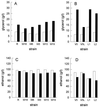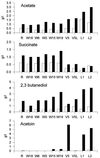Glycerol overproduction by engineered saccharomyces cerevisiae wine yeast strains leads to substantial changes in By-product formation and to a stimulation of fermentation rate in stationary phase
- PMID: 9872772
- PMCID: PMC90995
- DOI: 10.1128/AEM.65.1.143-149.1999
Glycerol overproduction by engineered saccharomyces cerevisiae wine yeast strains leads to substantial changes in By-product formation and to a stimulation of fermentation rate in stationary phase
Abstract
Six commercial wine yeast strains and three nonindustrial strains (two laboratory strains and one haploid strain derived from a wine yeast strain) were engineered to produce large amounts of glycerol with a lower ethanol yield. Overexpression of the GPD1 gene, encoding a glycerol-3-phosphate dehydrogenase, resulted in a 1.5- to 2.5-fold increase in glycerol production and a slight decrease in ethanol formation under conditions simulating wine fermentation. All the strains overexpressing GPD1 produced a larger amount of succinate and acetate, with marked differences in the level of these compounds between industrial and nonindustrial engineered strains. Acetoin and 2,3-butanediol formation was enhanced with significant variation between strains and in relation to the level of glycerol produced. Wine strains overproducing glycerol at moderate levels (12 to 18 g/liter) reduced acetoin almost completely to 2,3-butanediol. A lower biomass concentration was attained by GPD1-overexpressing strains, probably due to high acetaldehyde production during the growth phase. Despite the reduction in cell numbers, complete sugar exhaustion was achieved during fermentation in a sugar-rich medium. Surprisingly, the engineered wine yeast strains exhibited a significant increase in the fermentation rate in the stationary phase, which reduced the time of fermentation.
Figures



Similar articles
-
Effects of GPD1 overexpression in Saccharomyces cerevisiae commercial wine yeast strains lacking ALD6 genes.Appl Environ Microbiol. 2006 Jul;72(7):4688-94. doi: 10.1128/AEM.02975-05. Appl Environ Microbiol. 2006. PMID: 16820460 Free PMC article.
-
Reduction of ethanol yield and improvement of glycerol formation by adaptive evolution of the wine yeast Saccharomyces cerevisiae under hyperosmotic conditions.Appl Environ Microbiol. 2014 Apr;80(8):2623-32. doi: 10.1128/AEM.03710-13. Epub 2014 Feb 14. Appl Environ Microbiol. 2014. PMID: 24532067 Free PMC article.
-
Engineering of 2,3-butanediol dehydrogenase to reduce acetoin formation by glycerol-overproducing, low-alcohol Saccharomyces cerevisiae.Appl Environ Microbiol. 2009 May;75(10):3196-205. doi: 10.1128/AEM.02157-08. Epub 2009 Mar 27. Appl Environ Microbiol. 2009. PMID: 19329666 Free PMC article.
-
Modulation of glycerol and ethanol yields during alcoholic fermentation in Saccharomyces cerevisiae strains overexpressed or disrupted for GPD1 encoding glycerol 3-phosphate dehydrogenase.Yeast. 1997 Jul;13(9):783-93. doi: 10.1002/(SICI)1097-0061(199707)13:9<783::AID-YEA128>3.0.CO;2-W. Yeast. 1997. PMID: 9234667
-
Flavor impacts of glycerol in the processing of yeast fermented beverages: a review.J Food Sci Technol. 2015 Dec;52(12):7588-98. doi: 10.1007/s13197-015-1977-y. Epub 2015 Aug 1. J Food Sci Technol. 2015. PMID: 26604336 Free PMC article. Review.
Cited by
-
Effects of GPD1 overexpression in Saccharomyces cerevisiae commercial wine yeast strains lacking ALD6 genes.Appl Environ Microbiol. 2006 Jul;72(7):4688-94. doi: 10.1128/AEM.02975-05. Appl Environ Microbiol. 2006. PMID: 16820460 Free PMC article.
-
Expanding a dynamic flux balance model of yeast fermentation to genome-scale.BMC Syst Biol. 2011 May 19;5:75. doi: 10.1186/1752-0509-5-75. BMC Syst Biol. 2011. PMID: 21595919 Free PMC article.
-
Optogenetic Modification of Glycerol Production in Wine Yeast.ACS Synth Biol. 2025 Mar 21;14(3):719-728. doi: 10.1021/acssynbio.4c00654. Epub 2025 Feb 14. ACS Synth Biol. 2025. PMID: 39951366
-
Reduction of ethanol yield and improvement of glycerol formation by adaptive evolution of the wine yeast Saccharomyces cerevisiae under hyperosmotic conditions.Appl Environ Microbiol. 2014 Apr;80(8):2623-32. doi: 10.1128/AEM.03710-13. Epub 2014 Feb 14. Appl Environ Microbiol. 2014. PMID: 24532067 Free PMC article.
-
Production of 2,3-butanediol in Saccharomyces cerevisiae by in silico aided metabolic engineering.Microb Cell Fact. 2012 May 28;11:68. doi: 10.1186/1475-2859-11-68. Microb Cell Fact. 2012. PMID: 22640729 Free PMC article.
References
-
- Albertyn J, Hohmann S, Thevelein J M, Prior B A. GPD1, which encodes glycerol-3-phosphate dehydrogenase is essential for growth under osmotic stress in Saccharomyces cerevisiae and its expression is regulated by the high-osmolarity glycerol response pathway. Mol Cell Biol. 1994;14:4135–4144. - PMC - PubMed
-
- Bely M, Sablayrolles J M, Barre P. Automatic detection of assimilable nitrogen deficiencies during alcoholic fermentation in enological conditions. J Ferment Bioeng. 1990;70:246–252.
-
- Bidenne C, Blondin B, Dequin S, Vezhinet F. Analysis of the chromosomal DNA polymorphism of wine yeast strains of Saccharomyces cerevisiae. Curr Genet. 1992;22:1–7. - PubMed
-
- Blomberg A, Adler L. Physiology of osmotolerance in fungi. Adv Microb Physiol. 1992;33:145–212. - PubMed
LinkOut - more resources
Full Text Sources
Other Literature Sources
Molecular Biology Databases
Miscellaneous

